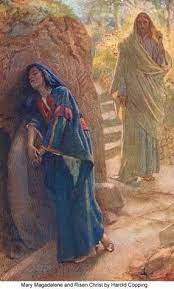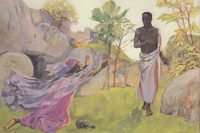[This is Part Two of my Easter meditation on Resurrection Among the Ruins preached at St. Andrew’s Presbyterian Church, Lindsay. Part One was an extended reflection on Isaiah’s vision of a New Heavens and a New Earth. Part Two attends to the resurrection appearance to Mary Magdalene in John 20.1-18 and asks, whether Isaiah’s vision was any more imaginable to Mary as it was to the ancient prophet.]
Did Mary Magdalene have a resurrection spirituality?
Did Mary come to the grave with such an audacious hope?
Did she expect resurrection?
Did she expect the fulfilment of Isaiah’s prophecy?
I don’t think so.
You see, for Mary, Isaiah’s vision
of a new heavens and a new earth
remained profoundly unfulfilled.
Not only had Jerusalem proven again
to be a place of violence, not shalom,
in this week of weeks …
the idea of Jerusalem as a delight,
or of Jerusalem as a place of joy,
was a cruel mockery of reality.
Over the last number of days,
Mary’s world had collapsed.
Her dreams were dashed.
Her hope was taken from her.
Her faith was in tatters.
The “No Mores” of Isaiah
had devolved into the devastating
same old, same old of …
violence,
weeping,
cries of distress,
death,
homelessness,
exploitation,
calamity,
and injustice
that had characterized her life
before he had come.
While the community had collapsed
into betrayal, denial, and fear.
No wonder, even the sun refused to shine.
Dare she hope for resurrection,
among the ruins of her life?
Could she possibly have been able
to imagine a new heavens and a new earth?
No.
But …
On the first day of the week,
while it was still dark,
this woman had the courage
to go to the tomb.
Through her despair,
with eyes swollen from her tears,
knowing that it was over, it wasn’t going any further,
Mary went to the garden where Jesus had been laid.
Why?
Why did this woman,
– all by herself in John’s telling of the story –
go to the tomb?
She went to wail.
She went to weep at the tomb.
She went to stand vigil at the grave,
in sorrow,
in lament,
in tears.
And things went from bad to worse.
The stone was rolled away.
The grave had been desecrated.
And the body of Jesus was gone.
So she ran.
She ran and ran and ran,
until she came to the place
where the men were lost in their own grief.
John and Peter were out the door in a flash.
And they ran.
They ran and ran and ran,
until they came to the tomb,
and confirmed the worse.
The body was gone.

They went home,
“but Mary stood weeping
outside the tomb.”
They went home,
but Mary stayed.
She had come to weep at the tomb,
and now she had even more reason for her tears.
She had come to lament the death of her Lord,
the death of her hope,
the death of her dreams,
… perhaps the death of her faith?
But now the lament became
all the more desperate,
all the more hopeless.
So when she saw the two angels
– how John and Peter didn’t see them, I don’t know –
and when they asked her, “Woman, why are you weeping?”,
Mary was so overwhelmed in her grief
that this angelic presence paled in comparison
and she replied directly,
“They have taken away my Lord,
and I do not know where they have laid them.”
Mary had no time to be impressed by two angels.
To her, the wonder and mystery of it all was irrelevant.
All she wanted was to find the body of her Lord.
So she turned away from these heavenly creatures
and saw a man standing there.
The man asked her the same question,
“Woman, why are you weeping?”
but then added,
“Whom are you looking for?”
Blinded by her grief,
buried under the ruins of her hope,
Mary couldn’t recognize
that this man was Jesus.
She had no resurrection imagination
that could open her eyes to the
dawning of a new heavens and a new earth
right before her.
Nonetheless, showing again her courage
and her single-minded longing
to find the body of her Lord,
and supposing that this man
was the gardener, the caretaker,
the steward of this garden,
Mary replied,
“Sir, if you carried him away,
tell me where you have laid him,
and I will take him away.”

And then … well, then
the gardener said her name, “Mary.”
And in that naming,
her eyes were open.
In that naming,
light broke through her darkness.
In that naming,
hope was restored in the ruins.
In that naming,
a resurrection spirituality was born.
“Before they call, I will answer,”
wrote the prophet.
Before Mary had the imagination
to look for resurrection,
the risen One looked for her.
Before Mary had the imagination
to call out to her Lord on such a dark morning,
her Lord called out to her.
Before Mary had the imagination
to name Jesus again as her Rabbouni,
(her rabbi, her teacher),
Jesus named her, “Mary.”
In that naming,
in the intimacy and love of that naming,
in the deep recognition of this sister, this daughter,
a new heavens and a new earth breaks forth.
In that naming,
the story that had come to a tragic ending,
begins anew.
In that naming,
in a garden,
with a man mistaken to be the gardener,
there is new creation.
It is such a lovely mistake.
Mary thought he was the gardener.
But he was the gardener.
He is the gardener.
Here we have a man and a woman,
in a garden.
It is early, the first day of the week.
It seems to be the ending of all endings.
But this ending meets a radical new beginning
as a gardener names a woman,
in love and respect,
with tenderness and care,
in recognition and hope.
If this is the story of new creation,
if resurrection is not about going to heaven,
but of the restoration of all of creation,
if this is how the fulfilment of Isaiah’s vision begins,
then might this be the rebirth of hope
for a city of shalom?
for streets of joy?
for weeping to give way to delight?
Mary came to the tomb,
under the ruins of her faith, her hope, her dreams.
And resurrection happened among those ruins.
It seems to me that we also come to this Easter morning,
among the ruins.
The ruins of our traditions, of our churches.
The ruins of our institutions, of our democracies.
The ruins of our economy, as poverty rises.
The ruins of our environment,
in the face of climate collapse.
The ruins of civic decency, in the divisiveness of our times.
The ruins of human rights
under the weight of genocide and deportations.
The ruins of home, as so much collapses all around us.
So here’s my question, dear sisters, brothers and siblings in Christ.
Do you hear Jesus call your name this morning?
Is your life animated by a resurrection spirituality?
And does that resurrection spirituality
give voice to a defiant “Hallelujah”
in a culture of death?
You see, this a resurrection spirituality
that cries out …
no more weeping,
no more cries of distress,
no more homelessness,
no more exploitation,
no more calamity,
no more genocide,
no more injustice.
My friends, Christ is Risen.
Hear your name.
Embrace the new life on offer.
Cry Hallelujah, even against the evidence.
Practice Resurrection.